While I was working on the 2nd build up of Lady, I acquired a pair of D44 rear axle shafts quite unexpectedly. I had bought some used 35″ MT/Rs from a Tucson Jeeper and he had brought them up to the Phoenix area while visiting a friend. I had gone across town to pick up the tires and was loading them into the back of the TJ when his friend asked me if I was running a D44 on the rear. I told him I was and he told me to not to leave until he got back. A few minutes later, he reappeared with a pair of D44 axle shafts and put them in with the tires. No charge….he had nothing to use them in and didn’t want to toss them out. Lucky me!
It has been a few months since I got those shafts and thought it was time to make them trail worthy. Having them sitting in the garage was doing little for ensuring an easy trail repair should I experience a problem climbing over the rocks. About 10 minutes with a wire brush got the surface rust off of the shafts and looking pretty good. The bearings were visibly bad and the seal would need replacing just because it was the smart thing to do.
I picked up a new set of Timken bearings and seals at the local 4×4 shop. I thumbed through the factory manual and read up on the procedure. It looked easy enough. Drill the a hole in the bearing retainer and then cut it with a cold chisel. Put the shaft on a hydraulic press and remove the bearing. Slip the seal off the shaft. That all there is to it Piece of cake.
My buddy Alan, who you might remember from the transfer case episode, has a 25 ton press in his garage. Unfortunately, after we talked about doing this work, we realized that his press would work fine for installing the new bearing and retainer. However, it would not be able to press the bearing off since it doesn’t have enough distance between the ram and the platform where the v-blocks hold the bearing separator. So….using it for the install was a go but we needed another game plan for removing the bearings.
Since I had no need for the parts coming off the axle shafts, it made little difference if they were destroyed while being removed. With that in mind, I gathered up my Dremel tool (with a supply of cut off discs), the axles and the new parts, and headed over to Alan’s.
Before I get started here…let me stress that you must use good eye protection. The Dremel cutting discs are very easy to break. The rotational speed of the cutting wheel will send broken pieces flying through the air so fast that you’ll never know what hit you!
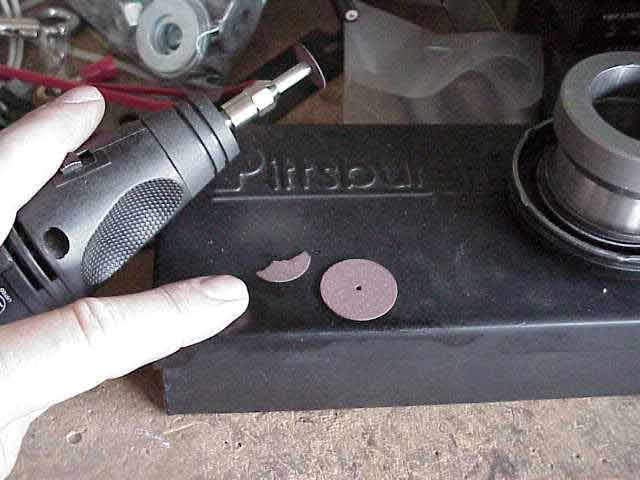
So….do yourself, your family, and your friends a BIG favor by wearing safety glasses while doing your shop work.
The first step was easy enough. A drill bit, just slightly smaller in diameter than the width of the bearing retainer, was selected and chucked into the drill press. Alan steadied the end of the shaft while I drilled a hole into the retainer. I took it easy as I didn’t want to punch through the retainer and drill the axle shaft.
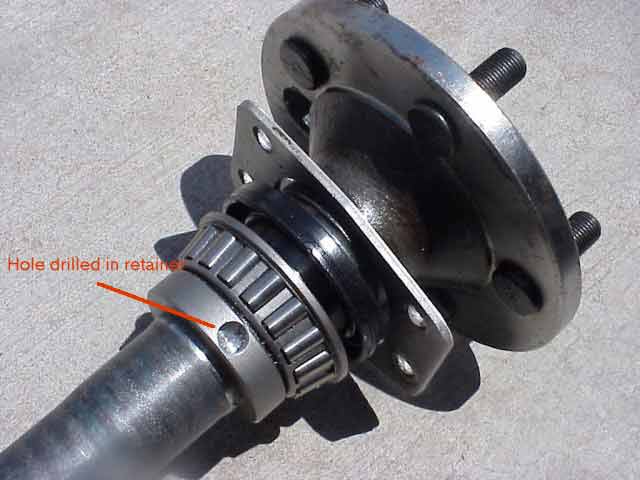
Here is a picture of the retainer ring with a freshly drilled hole drilled squarely into it. At this point, the factory manual says to take a cold chisel and place it across the hole and strike it so as to crack the retainer ring.
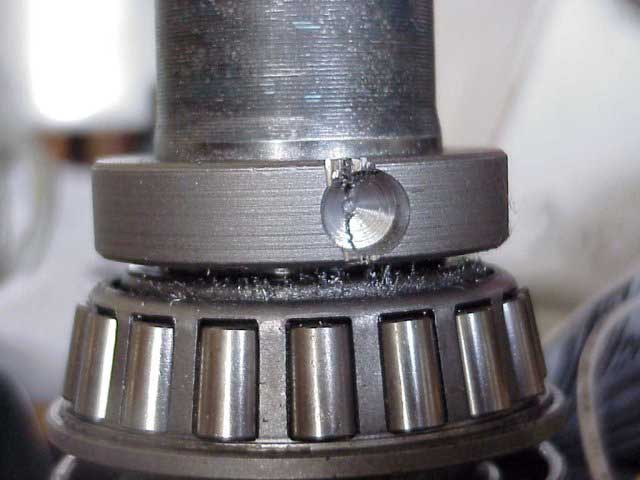
I cheated just a bit. I grabbed the Dremel tool and put a couple of cuts right across the hole. As I was cutting, there was a snap as the retaining ring split apart. The tension it was under from being pressed onto the axle shaft was obviously very great. You can see the crack in the above picture.
I took the chisel at this point and hit it a couple of good whacks. The retainer spread just enough so I could slide it (and the chisel that was stuck in the ring) down the axle shaft.
D44 Overhaul
With the bearing retainer out of the way, the next step was the bearing itself. Both of the bearings (on each axle) already had the outer race loose, so I just slipped it off. Had it not been so, I would have cut this off with the Dremel disc as well.

I started on the bearing, cutting through each “layer” of it and peeling off a piece at a time. In the above pic, I have just finished cutting this part and found that a screwdriver was just what the doctor ordered to pry it off.
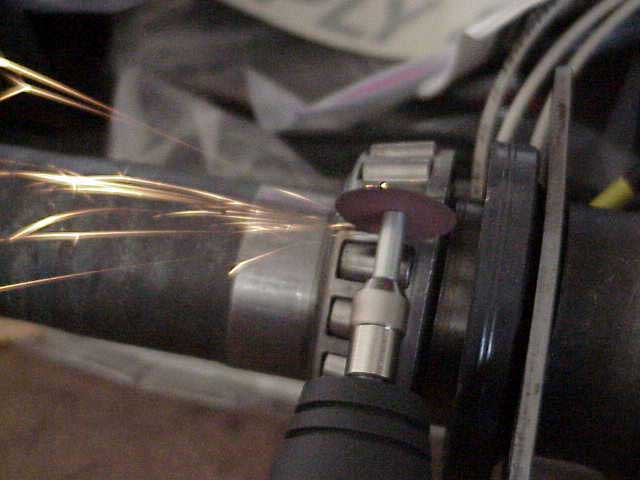
Next was the cage part of the bearing…the part that holds the rollers all in the right spots. That was quite easy to cut through. It took about a 1 minute with the disc, maybe less.

The screwdriver once again proved to be the right tool to remove the cage. Watch out for those razor sharp edges that the cutting disc will leave behind. You’ll slice your finger if you get it in there and try to peal the metal out of the way by hand.
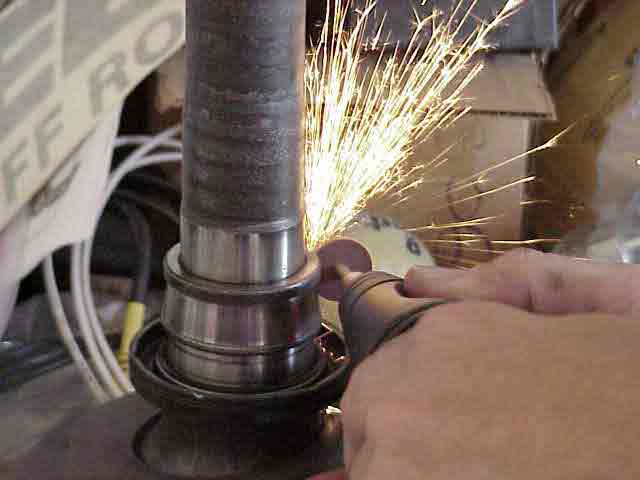
The last piece to be removed was that part of the bearing assembly that fits directly on the shaft. The pic above shows how I did this one. First, push the seal down and out of the way and then make your cut in line with the shaft, just like you did on the bearing retainer. Be careful not to cut into the axle shaft. Take your time and slow cut through the metal. Stop fairly often and see how close you are getting to the shaft.
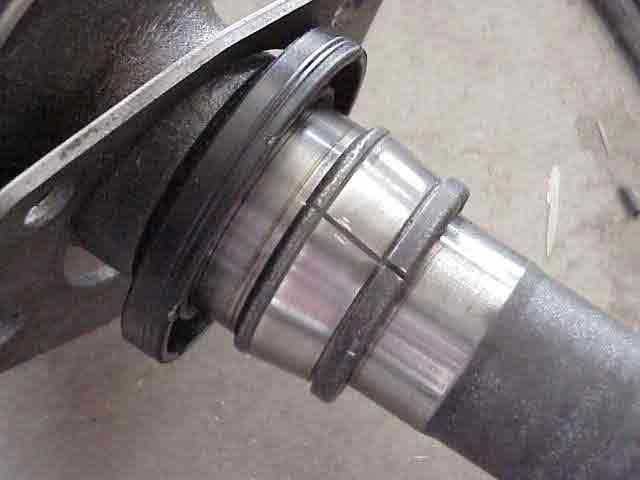
As you can see in the pic above, a nice clean cut can be made without nicking the shaft. Take your time and yours will come out this nicely too.
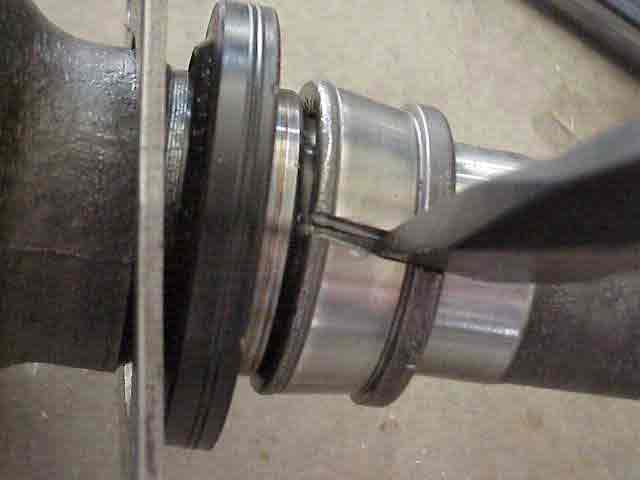
This one came apart on the first whack with the hammer and chisel. Here is the chisel, still in position. You can see that the gap has widened significantly and this is more than enough to allow you to slip it off the shaft. Don’t pull the chisel out until you have it off the shaft. If you remove it right now, the collar will snap back together and you’ll need to pry it apart again with the chisel.
D44 Overhaul
With the bearing now removed, you can now slip the oil seal off of the shaft.

Note the position of the seal before removing it. Wouldn’t you feel kind of silly if you put the new seal on backwards? After all of that hard work and then….DOH!
OK….so you have everything taken off. Time to clean off the axle shafts. You don’t need those metal filings from the drilling and cutting operations. That would defeat the whole purpose of what we are doing.
The factory manual states that you should verify that the retaining plate (last thing now left on your axle shaft) is not warped. If it is, you need to replace it. The manual says to use a suitable straight edge to check the plate for flatness. I will leave it up to you to determine if your retaining plate is warped or not.
Next, apply a thin coat of multi-purpose grease on the sealing surface of the axle seal. Neglecting to do this will lead to the early failure of your new seal. Slide the seal onto the shaft axle with the cavity away from the retaining plate….(ie., the open side of the seal is facing the spline end of the shaft.
Next, lubricate the bearing with wheel bearing grease. Wipe the excess grease from the outside of the bearing. In my case, my Timken bearings were pre-greased and ready to install. I checked them carefully, just to be sure, and they did a good job.
Slide the bearing onto the axle shaft. You did pay attention to how it looked when you took it off, right? Don’t worry, the Timken bearing comes with some instructions for you to follow if you need to. The factory manual says to press the bearing on and then press the retainer on.
I hadn’t read the manual for a few days and forgot about pressing the bearing and retainer on using two separate steps. Instead, I pressed them on together. From what I can see, it didn’t hurt anything and the final results are exactly what I wanted.
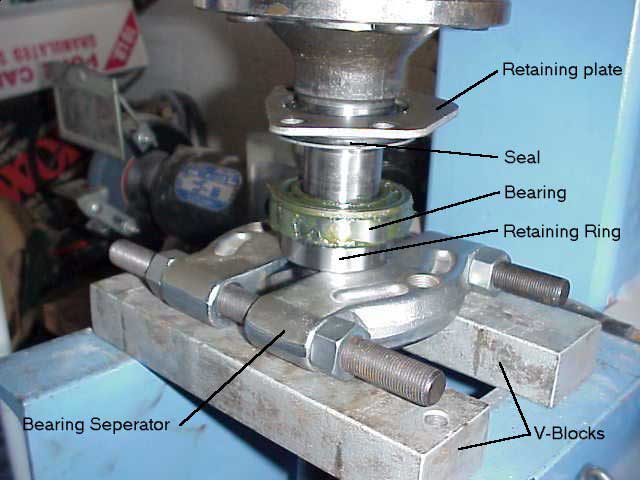
Here is how we did it, doing both the bearing and retaining ring at the same time. We made sure everything was square to the world….the bearing and retraining ring were seated properly and not going on crooked.
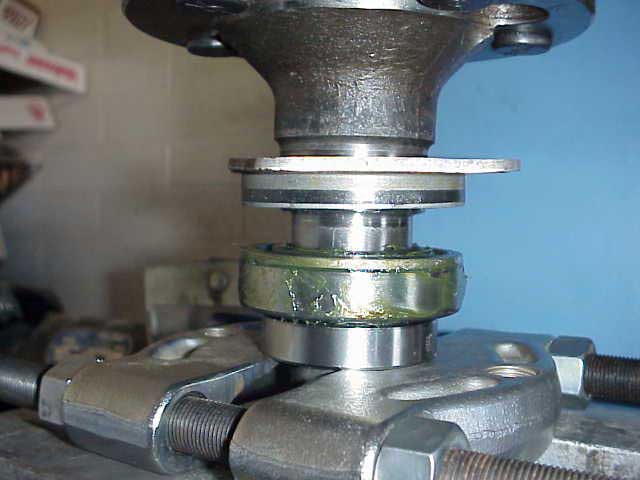
There is about a 1/4″ of axle shaft left before the bearing will seat against the shoulder. You could tell when it seated as the press pressure went up significantly.
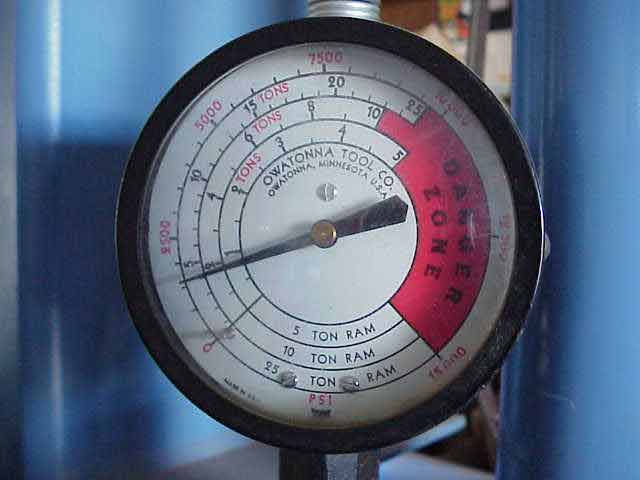
This was the last stroke before we called it good. The pressure went up to 6 tons on the last stroke and you could hear it seat home (don’t ask, you had to be there). I don’t think this was one of those jobs you would want to do with a drift punch and a 3 pound hammer!
With the first shaft assembled, Alan and I grabbed the remaining parts and finished up the second one. I took them back to my place and wrapped them up to keep any dust and dirt out of the bearings. I used the same plastic wrap that they use to keep boxes on shipping pallets….the heavy duty stuff that sticks to itself, just like Saran Wrap. Works great for wrapping up the axles. It protects the splines and keeps the bearings clean (and no greasy mess in your vehicles either). I had a bunch of lug nuts left over from my old rims. I put them on the studs so as to protect the threads. After they were all wrapped up, I shuffled the gear around in the left compartment of my storage box and made room for them in there. With luck, I will never use them!
